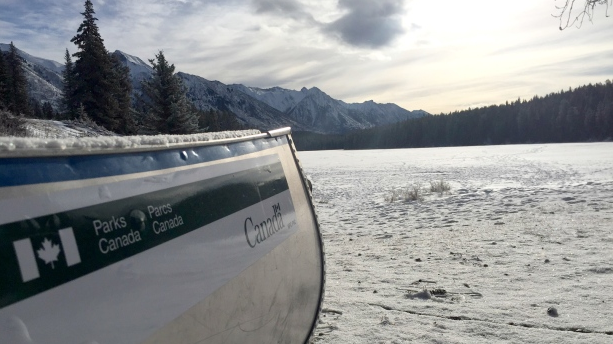Johnson Lake will be the subject a giant fish removal project to hopefully prevent the spread of whirling disease in Banff National Park.
How seriously are Alberta fisheries biologists taking the threat of whirling disease in Banff National Park? Very.
They’re removing fish from Johnson Lake in order to prevent the spread of the parasite to native west slope cutthroat trout in the Two Jack and Minnewanka lakes. The entire park only has 10 strong popualations of west slope cutthroat trout—much of Banff National Park is rock and ice. Whirling disease is already established in the Bow and Oldman river drainages, but officials want to keep it out of other lakes in the park where west slopes and mountain whitefish could be susceptible.
Spring is spawning season for much of the west’s native fish, including cutthroat trout and Arctic grayling. Even in Alaska, where, in many cases, the ice is just coming off of rivers and sloughs, grayling are busy propogating the next generation of perhaps the best dry-fly salmonid on the planet.
As you’ll see in the video above, these fish spawn with some enthusiasm! I know I’m not alone in wishing them well. I’m tempted to ship a few candles and some good wine to the Arctic, just to make sure they get their business done well.
Often, it’s common to see conservationists and the agriculture industry at odds over water use, but that’s not the case in Nevada, where a proposed law would change the state’s water-use policies and put both ranchers and fish and wildlife in peril. The bill, which, according to TU’s Pam Harrington, is simply too ambiguous to garner support from the conservation community, could result in lower water tables and reduced water access for ranches and farms in the state. Additiionally, in one of the dryest states in the union, water resources for sensitve trout species like Lahontan cutthroats are already rare. Putting in peril those existing resources is simply unacceptable.
Finally, can you imagine your first casting a fly happening on the holy water of the Gallatin River? This river is where filmmakers turned Norman Maclean’s “A River Runs Through It” into “the movie,” after all. Well, reporter Brian Cantwell got that distinct privilege last fall, and he’s penned an interesting story that’s probably familiar to all of us if we think back to our first fishing adventure. Enjoy.
— Chris Hunt



